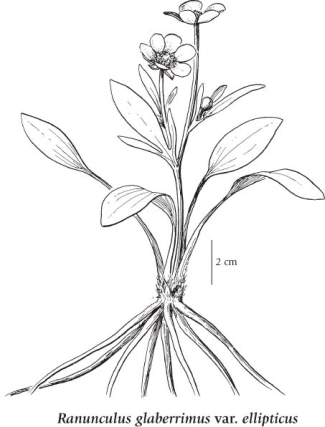Ranunculus glaberrimus var. ellipticus Hook. (Greene) Greene
sagebrush buttercup (elliptical buttercup)
Ranunculaceae (Buttercup family)
Introduction to Vascular Plants
sagebrush buttercup (elliptical buttercup)
Ranunculaceae (Buttercup family)
Introduction to Vascular Plants
Map click to expand contents
Distribution of Ranunculus glaberrimus var. ellipticus
Click here to view the full interactive map and legend
Species Information click to expand contents
General:
Perennial herb from cluster of fleshy roots, the roots 1-3 mm wide; stems prostrate to ascending, simple or branched above, 4-15 cm tall/long, smooth, not hollow.
Leaves:
Mostly basal, persistent, kidney- or egg-shaped, to narrowly elliptic, 0.7-5.2 cm long, 1-2 cm wide, margins entire or shallowly 3-lobed at tip, tips rounded to pointed, bases blunt to narrowed, the stalks long, slender; stem leaves alternate, unstalked or nearly so, deeply 3-lobed; smooth.
Flowers:
Inflorescence of 1- to 4-flowered, terminal cymes, on stalks to 10 cm long; receptacle smooth; petals 5-10 or more, distinct, yellow, 8-13 mm long, 5-12 mm wide, egg-shaped, nectary on upper surface, the nectary scale smooth or fringed with hairs, 1.5-2 mm long; sepals 5, early deciduous, spreading to bent back, 5-8 mm long, 3-7 mm wide, smooth above or sparsely hairy; stamens 40-80; pistils 30-150.
Fruits:
Achenes, numerous in a globe-shaped head 7-12 (20) mm long, 6-11 (20) mm wide, the achenes egg-shaped, plump, slightly winged, 1.4-2.2 mm long, 1.1-1.8 mm wide, usually minutely-hairy; beaks persistent, lanceolate- to awl-shaped, straight or curved, 0.4-1 mm long.
Notes:
Two sympatric and intergrading varieties occur in BC:
1. Basal leaf blades egg-shaped, usually shallowly lobed; stem leaves usually entire..................... var. glaberrimus
1. Basal leaf blades oblanceolate to elliptic, usually entire; stem leaves entire to 3-lobed..................... var. ellipticus Greene
Illustration click to expand contents

If more than one illustration is available for a species (e.g., separate illustrations were provided for two subspecies) then links to the separate images will be provided below. Note that individual subspecies or varietal illustrations are not always available.
Illustration Source: The Illustrated Flora of British Columbia
Ecology click to expand contents
Ecological Framework for Ranunculus glaberrimus var. ellipticus
The table below shows the species-specific information calculated from
original data (BEC database) provided by the BC Ministry of Forests and Range.
(Updated August, 2013)
The table below shows the species-specific information calculated from
original data (BEC database) provided by the BC Ministry of Forests and Range.
(Updated August, 2013)
| Site Information |
Value / Class |
||
|
Avg |
Min |
Max |
|
| Elevation
(metres) |
1264 | 1044 | 1478 |
| Slope
Gradient (%) |
37 | 15 | 70 |
|
Aspect (degrees) |
185 | 125 | 215 |
| Soil
Moisture Regime (SMR) [0 - very xeric; 4 - mesic; 8 - hydric] |
1 | 1 | 1 |
| Modal
Nutrient Regime
Class |
B | ||
| #
of field plots species was recorded in: |
3 | ||
| Modal
BEC Zone Class |
ICH | ||
|
All BEC Zones (# of stations/zone) species was recorded in |
ICH(3) | ||
|
Source:
Klinkenberg 2013
|
|||
Habitat and Range click to expand contents
Mesic to dry grasslands, shrublands, sandy flats, rocky slopes and open forests in the steppe and montane zones; common in S BC east of the Coast-Cascade Mountains, infrequent northward; E to SK and S to NB, ND, NM, AZ and CA.
Synonyms click to expand contents
Synonyms and Alternate Names:
Ranunculus ellipticus Greene
Ranunculus glaberrimus var. buddii B. Boivin